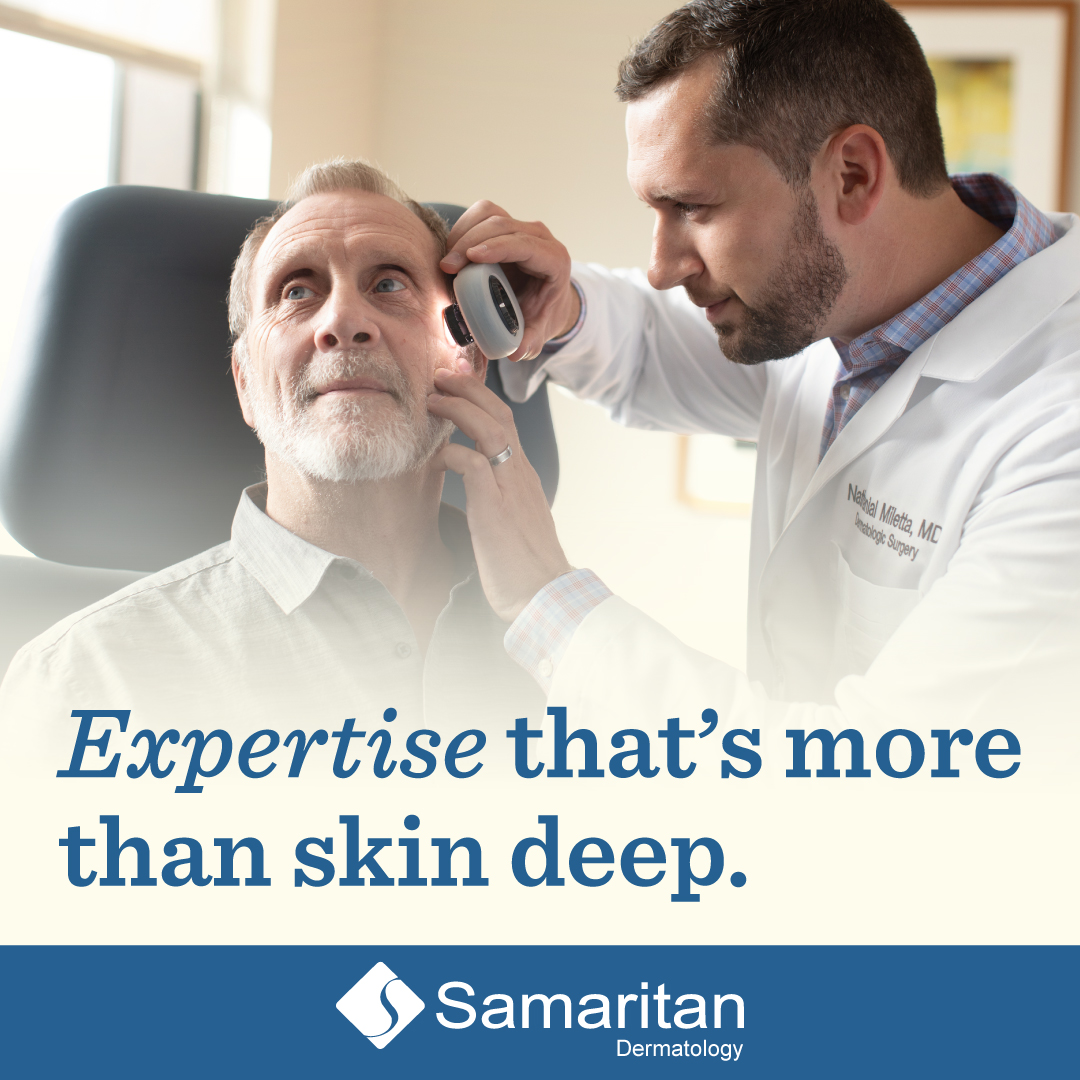Summer Skin Care Tips from the Experts: Samaritan Dermatology & Mohs Surgery
Published on: June 6, 2024
June is here, and with it come the first days of summer. This long-awaited season is a welcome change in the North Country, offering a break from the dark, chilly and wet conditions that begin our year. While it can be tempting to spend all day outdoors enjoying the warm weather, your skin will thank you — for years to come — if you take precautions in the summer sun.
When enjoyed responsibly, sunshine can benefit our health in ways we might not even realize. Sunny days lure us outside, often for physical or social activities such as walking, swimming, gardening or meeting friends — all of which benefit our general well-being. While we are out, exposure to sunlight prompts our skin to produce vitamin D, which is vital for bone health and immune function. Sunlight also stimulates the brain to produce serotonin, a chemical that naturally balances mood, sleep, digestion and other bodily functions.
Too much exposure to sunlight, however, comes with risks, especially when sun protection is not used. The sun’s ultraviolet (UV) radiation can damage skin cells, leading to sunburn, premature aging, and an increased risk of skin cancer. Surprisingly, this damage can occur faster than you might expect.
“For many people, 30 minutes of direct sun exposure will cause a sunburn,” says Samaritan Dermatologist and Mohs Surgeon Dr. Nathanial R. Miletta. “And, those with very light skin may experience a sunburn in as little as 10 to 15 minutes. Not only is a sunburn uncomfortable, but it’s a sign that your skin cells and their DNA have been damaged. Repeated sunburns cause your skin to age prematurely and can eventually lead to skin cancer.”
Skin Cancer: Common but Curable
Skin cancer is the most common form of cancer in the United States, and its prevalence continues to rise. In fact, current estimates show that one in five Americans will be diagnosed with skin cancer in their lifetime. While family history, race and age play some role in skin cancer risk, sun exposure is the dominant risk factor, causing more than 90 percent of skin cancers.
Fortunately, skin cancer can be cured when it is discovered in its early stages. State-of-the-art skin cancer treatment is available in the North Country at Samaritan Dermatology.

“Samaritan Dermatology is proud to offer our patients Mohs micrographic surgery for skin cancer, which has the highest tumor clearance rate and the smallest incisions,” Dr. Miletta said. “We are the only facility in the region to offer this method, which is 99% successful and leaves patients with the smallest possible scars.”
A Mohs surgery is typically performed while the patient is awake and uses local anesthesia to numb the tumor and surrounding skin. During the procedure, all visible parts of the tumor are removed, sent to an on-site laboratory, and sliced into thin sections for careful analysis. Using a microscope, the Mohs surgeon looks for cancer cells on the edges of the removed skin sections. If cancer cells are found near any edges, additional skin is removed and analyzed until no cancerous cells remain. Most Mohs surgery patients go home the same day as the procedure.
Being Safe in the Sun, and Still Having Fun
“Protecting your skin from overexposure is so important, not just during summer but all year long,” says Samaritan Dermatology Physician Assistant Erin Bryant. “With some simple precautions, you can still enjoy the outdoors — go to the beach, take a hike, garden and barbecue — without causing irreversible and life-threatening damage to your skin.”
Practicing sun safety does not mean hiding away indoors and avoiding your favorite outdoor activities. It involves knowing your risk, limiting your exposure and protecting your skin. Follow these guidelines from the American Academy of Dermatology to keep safe while you have fun in the sun:

- Apply sunscreen to all exposed skin. Use sunscreen that is water resistant, has an SPF (Sun Protection Factor) of at least 30, and is broad spectrum — meaning it protects you from both UVA and UVB rays. Reapply sunscreen every two hours or immediately after swimming.
- Wear protective clothingsuch as a long-sleeved shirt, pants, a wide-brimmed hat, and sunglasses, whenever possible. Look for clothing with a UV protection factor (UPF) or made of a tightly woven fabric.
- Seek shade when appropriate, remembering that the sun’s rays are the strongest between 10am and 2pm. Any time your shadow is shorter than you, seek shade.
- Protect your lips by using lip balm with at least SPF 15.
It’s also important to know your risk. Keeping track of the UV index, which forecasts the strength of UV rays each day, can help you plan the best times to be outside and the best times to stay out of the sun.
“When the UV index is between zero and two, you can enjoy being outside with little to no exposure risk,” Dr. Miletta said. “On days where the UV index is between three and seven, be sure to use sunscreen and seek shade during the middle of the day. And, on any day with a UV index of eight or above, it’s best to stay in the shade as much as possible. Sunscreen, protective clothing and a hat are especially necessary on these high-UV index days.”
Checking Your Skin for Warning Signs
Finding skin cancer early is one of the best ways to ensure it can be treated successfully, and you can perform skin exams in your own home. As you examine moles and marks on your skin, consider the ABCDEs of melanoma:
- A stands for Asymmetry: does the shape of one side match the other?
- B stands for Border: does the mole have uneven or irregular borders?
- C stands for Color: has the color of the mole changed, or does it appear varied?
- D stands for Diameter: is the mole larger than ¼” in diameter?
- E stands for Evolution: have you noticed changes in size, shape or color?
Contact your doctor or a dermatologist for further examination if you notice any of these symptoms. If you receive a skin cancer diagnosis, trust the experts at Samaritan Dermatology & Mohs Surgery to give you peace of mind about your treatment.
“We encourage anyone who has a diagnosed melanoma or other form of skin cancer to come see us and learn about Mohs micrographic surgery,” says Samaritan Dermatology Physician Assistant Amy Werchinski. “Our staff can provide care you won’t find anywhere else in the North Country.”
Samaritan Dermatology is located in the Samaritan Medical Office Building at 830 Washington Street in Watertown, NY. Satellite dermatology services are also offered at Samaritan’s LeRay and Adams Family Health Centers.
To learn more about services offered, conditions treated, and Samaritan Dermatology’s staff, visit samaritanhealth.com/dermatology or call the office at 315-755-3670.

